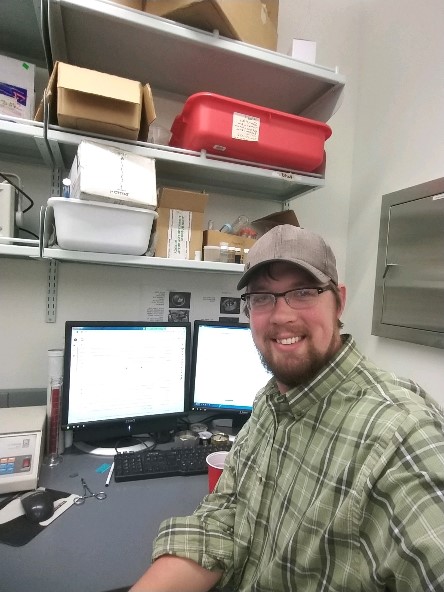Event Location:
CGG
10300 Town Park Dr.
Houston, TX 77072
NOTE: You Must be Logged In to Register.
 Porosity Prediction Using the Spectral Decomposition Attributes and Machine Learning
Porosity Prediction Using the Spectral Decomposition Attributes and Machine Learning
Rock property estimation directly from seismic data is limited by data quality and the mismatched scales of seismic attributes and geological layering. I propose to investigate the utilization of spectral decomposition attributes combined with deep learning techniques to address this problem. First, the seismic data will be decomposed into different frequency component using different spectral decomposition methods. A variety of seismic attributes will be extracted from these cubes. Deeply nested neural networks will be used to simultaneously predict rock properties logs filtered to different resolutions. These will then be summed to create broad-band rock property log predictions. Out of sample tests will be used to validate the predictions at different scales - thereby isolating only those scales that can be robustly predicted. The algorithm will be tested on a 3D seismic where porosity and clay volume will be estimated in a clastic formation. The results obtained will be compared to results obtained using current rock properties prediction practice including Multivariate Linear Regression, Multi-Layer Feedforward Neural Networks, and Probabilistic Neural Networks.
Speaker Biography: Lian Jiang, University of Houston
Lian Jiang is a fifth year’s Ph.D student in geophysics at University of Houston. He obtained his bachelor degree in 2008 and master degree in 2011, and both of them from geophysics. Immediately after graduation, he joined in China National Offshore Oil Corporation (CNOOC) and worked there for around four years, where his main tasks were seismic/geological interpretation, seismic well ties, seismic attributes analysis, seismic inversion, and rock physics/petrophysics analysis. Then, he came back to school to pursue his Ph.D at university of Houston. His current research includes prestack inversion/AVO, rock physics modeling, and deep learning.
 2-Dimensional Low-Field (2 MHz) NMR for Identification of Fluids in Unconventional Reservoirs
2-Dimensional Low-Field (2 MHz) NMR for Identification of Fluids in Unconventional Reservoirs
Proton nuclear magnetic resonance (NMR) has been used in petrophysical applications to study fluid composition and rock-fluid interactions in porous media. Primary interest for exploration and production of petroleum reservoirs resides in the characterization of reservoir fluids and determination of porosity and pore size distribution (PSD) of the rock matrix. NMR experiments record the relaxation and polarization of in-situ hydrogen protons present in gaseous phases such as free-gas intervals and solution gas fluids, bulk fluid phases such as oil and aquifer intervals, and immovable fractions of kerogen and bitumen. Here, 2-dimensional mapping of longitudinal (T1) and transverse relaxation (T2) (T1-T2 maps) as thermal maturity of a water-saturated, sub-mature Woodford shale is increased at temperatures from 125 to 400 degrees Celsius is presented. Measurements were performed on samples of the same Woodford outcrop following different thermal maturation steps during hydrous pyrolysis experiments. Observable 2D NMR shifts in immature kerogen formations as thermal maturity is increased show generation of lighter oils with increased maturity. Investigation of hydrocarbon viscosity through access to different heavy oil samples from vintage oil fields is also performed using T1-T2 maps to characterize bulk fluid response of differing viscosity of oils. This work serves as an outline of potential interpretation methods of 2D NMR maps in unconventional shales and improved fluid identification methods for estimation of oil and water fractions in these reservoirs.
Speaker Biography: Kurt Livo, Colorado School of Mines
Kurt Livo is currently a PhD candidate in Petroleum Engineering at the Colorado School of Mines. He is a research assistant working on low-field Nuclear Magnetic Resonance (NMR) and micro Computer Automated Tomography (µCT) properties of fluids and porous media in the OCLASSH and DHI Fluids research groups. Kurt’s research interests include pressure dependent NMR response for fluid relaxation and mineralogical controls on NMR derived properties in both unconventional and conventional reservoir rocks. His professional experience has included being an Oil and Gas bill writer and consultant for the Colorado House of Representatives, a reservoir engineer working on steam injection implementation and optimization in heavy oil reservoirs for Freeport-McMoRan Oil and Gas in Bakersfield, California, and a production and reservoir engineer for Schlumberger Petrotechnical Services working on petrophysical modeling and evaluation of the Mowry shale in the Powder River Basin of Wyoming. He also has worked as a petrophysicist for both QEP Resources and Oxy Oil and Gas on evaluation of NMR logs and integration of laboratory core data for fluid identification in the Permian Basin.
 Abstract:
Abstract:
Thin sections provide geoscientists with a wealth of information about a rock’s makeup and diagenetic history. However, the analysis of thin sections often requires many hours of manual labor, limiting the amount of analysis a single person can accomplish in a reasonable time frame. In this talk, we explore the use of machine learning methods to automate the process.
Speaker Biography: David Tang, University of Texas at Austin
David is currently a PhD student studying geophysics at the University of Texas at Austin. Prior to arriving in Austin, he received a Bachelor’s and Master’s degree in geophysics from the University of California, Berkeley. In his spare time, David enjoys swimming and mountain biking.
NOTE: You Must be Logged in to Register
5:15pm Refreshments
5:30pm Presentation Begins
6:30pm Adjourn
THANK YOU TO OUR GENEROUS SPONSORS:
GOLD SPONSOR:


